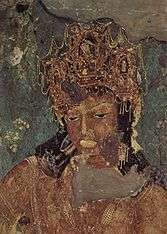Ajanta Caves
| Ajanta Caves | |
|---|---|
| Name as inscribed on the World Heritage List | |
.jpg) | |
| Type | Cultural |
| Criteria | i, ii, iii, vi |
| Reference | 242 |
| UNESCO region | Asia-Pacific |
| Coordinates | 20°33′05″N 75°42′12″E / 20.551356°N 75.703304°ECoordinates: 20°33′05″N 75°42′12″E / 20.551356°N 75.703304°E |
| Inscription history | |
| Inscription | 1983 (7th Session) |
 Location of Ajanta Caves in Maharashtra. | |
The Ajanta Caves in Aurangabad district of Maharashtra state of India are about 30 rock-cut Buddhist cave monuments which date from the 2nd century BCE to about 480 or 650 CE.[1][2] The caves include paintings and rock cut sculptures described as among the finest surviving examples of ancient Indian art, particularly expressive painting that present emotion through gesture, pose and form.[3][4][5] According to UNESCO, these are masterpieces of Buddhist religious art that influenced Indian art that followed.[6] The caves were built in two phases, the first group starting around the 2nd century BC, while the second group of caves built around 400–650 AD according to older accounts, or all in a brief period of 460 to 480 according to Walter M. Spink.[7] The site is a protected monument in the care of the Archaeological Survey of India,[8] and since 1983, the Ajanta Caves have been a UNESCO World Heritage Site.
The Ajanta Caves constitute ancient monasteries and worship halls of different Buddhist traditions carved into a 250 feet wall of rock.[9][10] The caves also present paintings depicting the past lives and rebirths of the Buddha, pictorial tales from Aryasura's Jatakamala, as well as rock-cut sculptures of Buddhist deities in vogue between the 2nd century BCE and 5th century CE.[9][11][12] Textual records suggest that these caves served as a monsoon retreat for monks, as well as a resting site for merchants and pilgrims in ancient India.[9] While vivid colours and mural wall painting were abundant in Indian history as evidenced by historical records, Caves 16, 17, 1 and 2 of Ajanta form the largest corpus of surviving ancient Indian wall-painting.[13]


The Ajanta Caves site are mentioned in the memoirs of several medieval era Chinese Buddhist travelers to India and by a Mughal era official of Akbar era in early 17th century.[14] They were covered by jungle until accidentally "discovered" and brought to the Western attention in 1819 by a colonial British officer on a tiger hunting party.[15] The Ajanta caves are located on the side of a rocky cliff that is on the north side of a U-shaped gorge on the small river Waghur,[16] in the Deccan plateau.[17][18] Further round the gorge are a number of waterfalls, which when the river is high are audible from outside the caves.[19]
With the Ellora Caves, Ajanta is the major tourist attraction of the Marathwada region of Maharashtra. They are about 60 kilometres (37 miles) from Bhusaval Junction railway station, 104 kilometres (65 miles) from the city of Aurangabad, and 350 kilometres (220 miles) east-northeast from Mumbai.[9][20] They are 100 kilometres (62 miles) from the Ellora Caves, which contain Hindu, Jain as well as Buddhist caves, the last dating from a period similar to Ajanta. The Ajanta style is also found in the Ellora Caves and other sites such as the Elephanta Caves and the cave temples of Karnataka.[21]
History
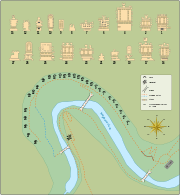
The Ajanta Caves are generally agreed to have been made in two distinct periods, the first belonging to the 2nd century BCE to 1st century CE, and second period that followed several centuries later.[22][23][24]
The caves consist of 36 identifiable foundations,[9] some of them discovered after the original numbering of the caves from 1 through 29. The later identified caves have been suffixed with the letters of the alphabet, such as 15A identified between originally numbered caves 15 and 16.[25] The cave numbering is a convention of convenience, and has nothing to do with chronological order of their construction.[26]
Caves of the first (Satavahana) period
.jpg)
The earliest group constructed consists of caves 9, 10, 12, 13 and 15A. This grouping and that they belong to the Hinayana (Theravada[26]) tradition of Buddhism is generally accepted by scholars, but there are differing opinions on which century the early caves were built.[27][28] According to Walter Spink, they were made during the period 100 BCE to 100 CE, probably under the patronage of the Hindu Satavahana dynasty (230 BCE – c. 220 CE) who ruled the region.[29][30] Other datings prefer the period of the Maurya Empire (300 BCE to 100 BCE).[31] Of these, caves 9 and 10 are stupa containing worship halls of chaitya-griha form, and caves 12, 13, and 15A are vihāras (see the architecture section below for descriptions of these types).[25]
According to Spink, once the Satavahana period caves were made, the site was not further developed for a considerable period until the mid-5th century.[32] However, the early caves were in use during this dormant period, and Buddhist pilgrims visited the site according to the records left by Chinese pilgrim Fa Hien around 400 CE.[25]
Caves of the later, or Vākāṭaka, period
The second phase of construction at the Ajanta Caves site began in the 5th century. For a long time it was thought that the later caves were made over an extended period from the 4th to the 7th centuries CE,[33] but in recent decades a series of studies by the leading expert on the caves, Walter M. Spink, have argued that most of the work took place over the very brief period from 460 to 480 CE,[32] during the reign of Hindu Emperor Harishena of the Vākāṭaka dynasty.[34][35][36] This view has been criticized by some scholars,[37] but is now broadly accepted by most authors of general books on Indian art, for example Huntington and Harle.
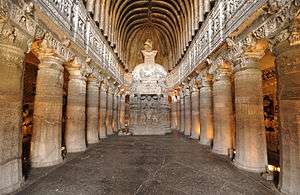
The second phase is attributed to the theistic Mahāyāna,[26] or Greater Vehicle tradition of Buddhism.[38][39] Caves of the second period are 1–8, 11, 14–29, some possibly extensions of earlier caves. Caves 19, 26, and 29 are chaitya-grihas, the rest viharas. The most elaborate caves were produced in this period, which included some refurbishing and repainting of the early caves.[40][26][41]
Spink states that it is possible to establish dating for this period with a very high level of precision; a fuller account of his chronology is given below.[42] Although debate continues, Spink's ideas are increasingly widely accepted, at least in their broad conclusions. The Archaeological Survey of India website still presents the traditional dating: "The second phase of paintings started around 5th – 6th centuries A.D. and continued for the next two centuries".
According to Spink, the construction activity at the incomplete Ajanta Caves was abandoned by wealthy patrons in about 480 CE, a few years after the death of Harishena. However, states Spink, the caves appear to have been in use for a period of time as evidenced by the wear of the pivot holes of caves constructed close to 480 CE.[43] According to Richard Cohen, 7th-century Chinese traveler Xuanzang's reports about the caves, and the scattered graffiti from the medieval centuries uncovered at the site suggests that the Ajanta Caves were known and probably in use, but without a stable or steady Buddhist community presence at the site.[14] The Ajanta caves are mentioned in the 17th-century text Ain-i-Akbari by Abu al-Fazl, as twenty four rock-cut cave temples each with remarkable idols.[14]
Discovery by the Western world
On 28 April 1819, a British officer named John Smith, of the 28th Cavalry, while hunting tiger, discovered the entrance to Cave No. 10 when a local shepherd boy guided him to the location and the door.[44] Captain Smith went to a nearby village and asked the villagers to come to the site with axes, spears, torches and drums, to cut down the tangled jungle growth that made entering the cave difficult.[44] He then vandalized the wall by scratching his name and the date over the painting of a bodhisattva. Since he stood on a five-foot high pile of rubble collected over the years, the inscription is well above the eye-level gaze of an adult today.[45] A paper on the caves by William Erskine was read to the Bombay Literary Society in 1822.[46]
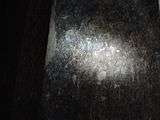
Within a few decades, the caves became famous for their "exotic" setting, impressive architecture, and above all their exceptional, all but unique paintings. A number of large projects to copy the paintings were made in the century after rediscovery. In 1848 the Royal Asiatic Society established the "Bombay Cave Temple Commission" to clear, tidy and record the most important rock-cut sites in the Bombay Presidency, with John Wilson as president. In 1861 this became the nucleus of the new Archaeological Survey of India.[47]
During the colonial era, the Ajanta site was in the territory of the princely state of the Nizam of Hyderabad rather than British India.[48] In early 1920s, the Nizam of Hyderabad appointed people to restore the artwork, converted the site into a museum and built a road to bring tourists to the site for a fee. These efforts resulted in early mismanagement, states Richard Cohen, and hastened the deterioration of the site. Post-independence, the state government of Maharashtra built arrival, transport, facilities and better site management.[48]
The Ajanta Caves, along with the Ellora Caves, have become the most popular tourist destination in Maharashtra, and are often crowded at holiday times, increasing the threat to the caves, especially the paintings.[49] In 2012, the Maharashtra Tourism Development Corporation announced plans to add to the ASI visitor centre at the entrance complete replicas of caves 1, 2, 16 & 17 to reduce crowding in the originals, and enable visitors to receive a better visual idea of the paintings, which are dimly-lit and hard to read in the caves.[50]
Paintings
Mural paintings survive from both the earlier and later groups of caves. Several fragments of murals preserved from the earlier caves (Caves 9 and 11) are effectively unique survivals of ancient painting in India from this period, and "show that by Sātavāhana times, if not earlier, the Indian painter had mastered an easy and fluent naturalistic style, dealing with large groups of people in a manner comparable to the reliefs of the Sāñcī toraņa crossbars".[51]
Four of the later caves have large and relatively well-preserved mural paintings which, states James Harle, "have come to represent Indian mural painting to the non-specialist",[51] and represent "the great glories not only of Gupta but of all Indian art".[52] They fall into two stylistic groups, with the most famous in Caves 16 and 17, and apparently later paintings in Caves 1 and 2. The latter group were thought to be a century or more later than the others, but the revised chronology proposed by Spink would place them in the 5th century as well, perhaps contemporary with it in a more progressive style, or one reflecting a team from a different region.[53] The Ajanta frescos are classical paintings and the work of confident artists, without cliches, rich and full. They are luxurious, sensuous and celebrate physical beauty, aspects that early Western observers felt were shockingly out of place in these caves presumed to be meant for religious worship and ascetic monastic life.[54]
The paintings are in "dry fresco", painted on top of a dry plaster surface rather than into wet plaster.[55] All the paintings appear to be the work of painters supported by discriminating connoisseurship and sophisticated patrons from an urban atmosphere. We know from literary sources that painting was widely practised and appreciated in the Gupta period. Unlike much Indian mural painting, compositions are not laid out in horizontal bands like a frieze, but show large scenes spreading in all directions from a single figure or group at the centre.[54] The ceilings are also painted with sophisticated and elaborate decorative motifs, many derived from sculpture.[53] The paintings in cave 1, which according to Spink was commissioned by Harisena himself, concentrate on those Jataka tales which show previous lives of the Buddha as a king, rather than as deer or elephant or another Jataka animal. The scenes depict the Buddha as about to renounce the royal life.[56]
In general the later caves seem to have been painted on finished areas as excavating work continued elsewhere in the cave, as shown in caves 2 and 16 in particular.[57] According to Spink's account of the chronology of the caves, the abandonment of work in 478 after a brief busy period accounts for the absence of painting in places including cave 4 and the shrine of cave 17, the later being plastered in preparation for paintings that were never done.[56]
Copies
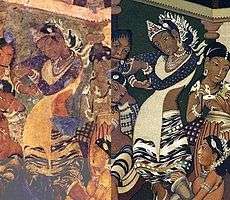
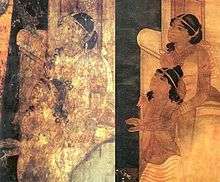
The paintings have deteriorated significantly since they were rediscovered, and a number of 19th-century copies and drawings are important for a complete understanding of the works. A number of attempts to copy the Ajanta paintings began in the 19th-century for European and Japanese museums. Some of these works have later been lost in natural and fire disasters. In 1846 for example, Major Robert Gill, an Army officer from Madras Presidency and a painter, was appointed by the Royal Asiatic Society to make copies of the frescoes on the cave walls.[59] Gill worked on his painting at the site from 1844 to 1863. He made 27 copies of large sections of murals, but all but four were destroyed in a fire at the Crystal Palace in London in 1866, where they were on display.[60] Gill returned to the site, and recommenced his labours, replicating the murals until his death in 1875.
Another attempt was made in 1872 when the Bombay Presidency commissioned John Griffiths to work with his students to make copies of Ajanta paintings, again for shipping to England. They worked on this for thirteen years and some 300 canvases were produced, many of which were displayed at the Imperial Institute on Exhibition Road in London, one of the forerunners of the Victoria and Albert Museum. But in 1885 another fire destroyed over a hundred of the paintings in storage in a wing of the museum. The V&A still has 166 paintings surviving from both sets, though none have been on permanent display since 1955. The largest are some 3 × 6 metres. A conservation project was undertaken on about half of them in 2006, also involving the University of Northumbria.[61] Griffith and his students had unfortunately painted many of the paintings with "cheap varnish" in order to make them easier to see, which has added to the deterioration of the originals, as has, according to Spink and others, recent cleaning by the ASI.[62]
A further set of copies were made between 1909 and 1911 by Christiana Herringham (Lady Herringham) and a group of students from the Calcutta School of Art that included the future Indian Modernist painter Nandalal Bose. The copies were published in full colour as the first publication of London's fledgling India Society. More than the earlier copies, these aimed to fill in holes and damage to recreate the original condition rather than record the state of the paintings as she was seeing them. According to one writer, unlike the paintings created by her predecessors Griffiths and Gill, whose copies were influenced by British Victorian styles of painting, those of the Herringham expedition preferred an 'Indian Renascence' aesthetic of the type pioneered by Abanindranath Tagore.[63]
Early photographic surveys were made by Robert Gill, who learnt to use a camera from about 1856, and whose photos, including some using stereoscopy, were used in books by him and Fergusson (many are available online from the British Library),[64] then Victor Goloubew in 1911 and E.L. Vassey, who took the photos in the four volume study of the caves by Ghulam Yazdani (published 1930–1955).[65]
Another attempt to make copies of the murals was made by the Japanese artist Arai Kampō (荒井寛方:1878-1945) after being invited by Rabindranath Tagore to India to teach Japanese painting techniques.[66] He worked on making copies with tracings on Japanese paper from 1916 to 1918 and his work was conserved at Tokyo Imperial University until the materials perished during the 1923 Great Kantō earthquake.
-
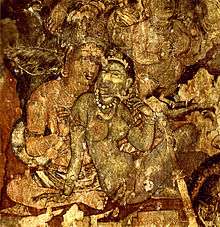
A painting from Cave 1. This cave features, states Spink, superb murals and imperial quality paintings.[1]
-
Cave 2, showing the extensive paint loss of many areas. It was never finished by its artists, and shows Vidhura Jataka.[2]
-
.jpg)
Section of the mural in Cave 17, the 'coming of Sinhala'. The prince (Prince Vijaya) is seen in both groups of elephants and riders.
-
_(13888446659).jpg)
Copy of Ajanta painting, in Musée Guimet, Paris
-
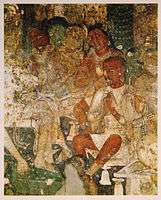
Hamsa jâtaka, cave 17. This painting probably shows one of the previous lives of the Buddha
- ^ Spink 2009, pp. 71-72, 132-139.
- ^ Spink 2009, p. 148, Figure 46.
- ^ Spink 2006, p. 19.
- ^ Spink 2009, pp. 201-202.
Significance
The Ajanta Caves painting are a significant source of socio-economic information in ancient India. The Cave 1, for example, shows some Sassanian (or Persian) characters, as do other paintings that states Spink, are "filled with such foreign" looking types.[67] This likely reflects merchants and visitors from the flourishing trade routes of that age.[67][68]
Architecture and sculpture
Site
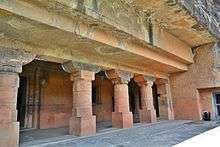
The caves are carved out of flood basalt rock of a cliff, part of the Deccan Traps formed by successive volcanic eruptions at the end of the Cretaceous geological period. The rock is layered horizontally, and somewhat variable in quality.[69] This variation within the rock layers required the artists to amend their carving methods and plans in places. The inhomogeneity in the rock have also led to cracks and collapses in the centuries that followed, as with the lost portico to cave 1. Excavation began by cutting a narrow tunnel at roof level, which was expanded downwards and outwards; as evidenced by some of the incomplete caves such as the partially-built vihara caves 21 through 24 and the abandoned incomplete cave 28.[70]
The sculpture artists likely worked at both excavating the rocks and making the intricate carvings of pillars, roof and idols; further, the sculpture and painting work inside a cave were an integrated parallel tasks.[71] A grand gateway to the site was carved, at the apex of the gorge's horseshoe between caves 15 and 16, as approached from the river, and it is decorated with elephants on either side and a nāga, or protective Naga (snake) deity.[72] Similar methods and application of artist talent is observed in other cave temples of India, although many with very different themes such as those from Hinduism and Jainism. These include the Ellora caves, Ghototkacha caves, Elephanta Caves, Bagh Caves, Badami Caves and Aurangabad Caves.[73]
The caves from the first period seem to have been paid for by a number of different patrons to gain merit, with several inscriptions recording the donation of particular portions of a single cave. The later caves were each commissioned as a complete unit by a single patron from the local rulers or their court elites, again for merit in Buddhist afterlife beliefs as evidenced by inscriptions such as those in Cave 17.[74] After the death of Harisena, smaller donors motivated by getting merit added small "shrinelets" between the caves or add statues to existing caves, and some two hundred of these "intrusive" additions were made in sculpture, with a further number of intrusive paintings, up to three hundred in cave 10 alone.[75]
Monasteries

The majority of the caves are vihara halls with symmetrical square plans. To each vihara hall are attached smaller square dormitory cells cut into the walls.[76] A vast majority of the caves were carved in the second period, wherein a shrine or sanctuary is appended at the rear of the cave, centred on a large statue of the Buddha, along with exuberantly detailed reliefs and deities near him as well as on the pillars and walls, all carved out of the natural rock.[77] This change reflects the shift from Hinayana to Mahāyāna Buddhism. These caves are often called monasteries.
The central square space of the interior of the viharas is defined by square columns forming a more or less square open area. Outside this are long rectangular aisles on each side, forming a kind of cloister. Along the side and rear walls are a number of small cells entered by a narrow doorway; these are roughly square, and have small niches on their back walls. Originally they had wooden doors.[78] The centre of the rear wall has a larger shrine-room behind, containing a large Buddha statue. The viharas of the earlier period are much simpler, and lack shrines.[79] Spink in fact places the change to a design with a shrine to the middle of the second period, with many caves being adapted to add a shrine in mid-excavation, or after the original phase.[80]
The plan of Cave 1 (right) shows one of the largest viharas, but is fairly typical of the later group. Many others, such as Cave 16, lack the vestibule to the shrine, which leads straight off the main hall. Cave 6 is two viharas, one above the other, connected by internal stairs, with sanctuaries on both levels.[81]
Worship halls


The other type of main hall architecture is the narrower rectangular plan with high arched ceiling type chaitya-griha – literally, "the house of stupa". This hall is longitudinally divided into a nave and two narrower side aisles separated by a symmetrical row of pillars, with a stupa in the apse.[82][83] The stupa is surrounded by pillars and a concentric walking space for circumambulation. Some of the caves have elaborate carved entrances, some with large windows over the door to admit light. There is often a colonnaded porch or verandah, with another space inside the doors running the width of the cave. The oldest worship halls at Ajanta were built in the 2nd to 1st century BCE, the newest ones in late 5th century CE, and the architecture of both resembles the architecture of a Christian church, but without the crossing or chapel chevette.[84] The Ajanta Caves follow the Cathedral-style architecture found in still older rock-cut cave carvings of ancient India, such as the Lomas Rishi Cave of the Ajivikas near Gaya in Bihar dated to the 3rd century BCE.[85] These chaitya-griha are called worship or prayer halls.[86][87]
The four completed chaitya halls are caves 9 and 10 from the early period, and caves 19 and 26 from the later period of construction. All follow the typical form found elsewhere, with high ceilings and a central "nave" leading to the stupa, which is near the back, but allows walking behind it, as walking around stupas was (and remains) a common element of Buddhist worship (pradakshina). The later two have high ribbed roofs carved into the rock, which reflect timber forms,[88] and the earlier two are thought to have used actual timber ribs and are now smooth, the original wood presumed to have perished.[89] The two later halls have a rather unusual arrangement (also found in Cave 10 at Ellora) where the stupa is fronted by a large relief sculpture of the Buddha, standing in Cave 19 and seated in Cave 26.[79] Cave 29 is a late and very incomplete chaitya hall.[90]
The form of columns in the work of the first period is very plain and un-embellished, with both chaitya halls using simple octagonal columns, which were later painted with images of the Buddha, people and monks in robes. In the second period columns were far more varied and inventive, often changing profile over their height, and with elaborate carved capitals, often spreading wide. Many columns are carved over all their surface with floral motifs and Mahayana deities, some fluted and others carved with decoration all over, as in cave 1.[91][92]
Cave by cave

Cave 1
Cave 1 was built on the eastern end of the horse-shoe shaped scarp and is now the first cave the visitor encounters. This cave, when first made, would have been a less prominent position, right at the end of the row. According to Spink, it is one of the last caves to have been excavated, when the best sites had been taken and was never fully inaugurated for worship by the dedication of the Buddha image in the central shrine. This is shown by the absence of sooty deposits from butter lamps on the base of the shrine image, and the lack of damage to the paintings that would have happened if the garland-hooks around the shrine had been in use for any period of time. Although there is no epigraphic evidence, Spink believes that the Vākāţaka Emperor Harishena was the benefactor of the work, and this is reflected in the emphasis on imagery of royalty in the cave, with those Jataka tales being selected that tell of those previous lives of the Buddha in which he was royal.[93]
The cliff has a more steep slope here than at other caves, so to achieve a tall grand facade it was necessary to cut far back into the slope, giving a large courtyard in front of the facade. There was originally a columned portico in front of the present facade, which can be seen "half-intact in the 1880s" in pictures of the site,[94] but this fell down completely and the remains, despite containing fine carvings, were carelessly thrown down the slope into the river, from where they have been lost.
This cave has one of the most elaborate carved façades, with relief sculptures on entablature and ridges, and most surfaces embellished with decorative carving. There are scenes carved from the life of the Buddha as well as a number of decorative motifs. A two pillared portico, visible in the 19th-century photographs, has since perished. The cave has a front-court with cells fronted by pillared vestibules on either side. These have a high plinth level. The cave has a porch with simple cells on both ends. The absence of pillared vestibules on the ends suggests that the porch was not excavated in the latest phase of Ajanta when pillared vestibules had become a norm. Most areas of the porch were once covered with murals, of which many fragments remain, especially on the ceiling. There are three doorways: a central doorway and two side doorways. Two square windows were carved between the doorways to brighten the interiors.[95]
Each wall of the hall inside is nearly 40 feet (12 m) long and 20 feet (6.1 m) high. Twelve pillars make a square colonnade inside supporting the ceiling, and creating spacious aisles along the walls. There is a shrine carved on the rear wall to house an impressive seated image of the Buddha, his hands being in the dharmachakrapravartana mudra. There are four cells on each of the left, rear, and the right walls, though due to rock fault there are none at the ends of the rear aisle.[96]
The walls and ceilings of Cave 1 are covered with paintings in a fair state of preservation, though the full scheme was never completed. The scenes depicted are mostly didactic, devotional, and ornamental, with scenes from the Jataka stories of the Buddha's former lives as a bodhisattva), the life of the Gautama Buddha, and those of his veneration. The two most famous individual painted images at Ajanta are the two over-life-size figures of the protective bodhisattvas Padmapani and Vajrapani on either side of the entrance to the Buddha shrine on the wall of the rear aisle (see illustrations above).[97][98]
Cave 1 also features a fresco with characters with foreign looking faces and dresses. One of these shows Sassanian (or Persian) characters bowing before an Indian king. According to Spink, James Fergusson, a 19th-century architectural historian, had decided that this scene corresponded to the Persian ambassador in 625 CE to the court of the Hindu Chalukya king Pulakeshin II.[67] An alternate theory has been that the fresco represents a Hindu ambassador visiting the Persian king Khusrau II in 625 CE, a theory that Fergusson disagreed with.[99][100] These assumptions by colonial British era art historians, state Spink and other scholars, has been responsible for wrongly dating this painting to the 7th century, when in fact this reflects an incomplete Harisena-era painting of a Jataka tale with the representation of trade between India and distant lands such as Sassanian near East that was common by the 5th century.[67][101][102]
Cave 2
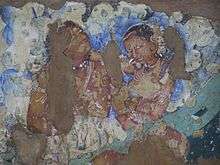
Cave 2, adjacent to Cave 1, is known for the paintings that have been preserved on its walls, ceilings, and pillars. It looks similar to Cave 1 and is in a better state of preservation. This cave is best known for its feminine focus, intricate rock carvings and paint artwork yet it is incomplete and lacks consistency.[103][104] One of the 5th-century frescoes in this cave also shows children at a school, with those in the front rows paying attention to the teacher, while those in the back row are shown distracted and acting.[105]
Cave 2 was started in the 460s, but mostly carved between 475 to 477 CE, probably sponsored and influenced by a woman closely related to emperor Harisena.[106] It has a porch quite different from Cave 1. Even the façade carvings seem to be different. The cave is supported by robust pillars, ornamented with designs. The front porch consists of cells supported by pillared vestibules on both ends.[107]
The hall has four colonnades which are supporting the ceiling and surrounding a square in the center of the hall. Each arm or colonnade of the square is parallel to the respective walls of the hall, making an aisle in between. The colonnades have rock-beams above and below them. The capitals are carved and painted with various decorative themes that include ornamental, human, animal, vegetative, and semi-divine motifs.[107] Major carvings include that of goddess Hariti. She is a Buddhist deity who originally was the demoness of smallpox and a child eater, who the Buddha converted into a guardian goddess of fertility, easy child birth and one who protects babies.[104][105]
The paintings on the ceilings and walls of this porch have been widely published. They depict the Jataka tales that are stories of the Buddha's life in former existences as Bodhisattva. Just as the stories illustrated in cave 1 emphasize kingship, those in cave 2 show many noble and powerful women in prominent roles, leading to suggestions that the patron was an unknown woman.[108] The porch's rear wall has a doorway in the center, which allows entrance to the hall. On either side of the door is a square-shaped window to brighten the interior.
Paintings appear on almost every surface of the cave except for the floor. At various places, the artwork has become eroded due to decay and human interference. Therefore, many areas of the painted walls, ceilings, and pillars are fragmentary. The painted narratives of the Jataka tales are depicted only on the walls, which demanded the special attention of the devotee. They are didactic in nature, meant to inform the community about the Buddha's teachings and life through successive rebirths. Their placement on the walls required the devotee to walk through the aisles and 'read' the narratives depicted in various episodes. The narrative episodes are depicted one after another although not in a linear order. Their identification has been a core area of research since the site's rediscovery in 1819. Dieter Schlingloff's identifications have updated our knowledge on the subject.
Cave 4

The Archaeological Survey of India board outside the caves gives the following detail about cave 4:"This is the largest monastery planned on a grandiose scale but was never finished. An inscription on the pedestal of the buddha's image mentions that it was a gift from a person named Mathura and paleographically belongs to 6th century A.D. It consists of a verandah, a hypostylar hall, sanctum with an antechamber and a series of unfinished cells. The rear wall of the verandah contains the panel of Litany of Avalokiteśvara". Spink, in contrast, dates this along with all other caves to pre-480 CE period.
The sanctuary houses a colossal image of the Buddha in preaching pose flanked by bodhisattvas and celestial nymphs hovering above.
Caves 9–10
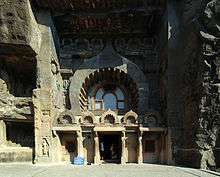
Caves 9 and 10 are the two chaitya halls from the first period of construction, though both were also undergoing an uncompleted reworking at the end of the second period. Cave 10 was perhaps originally of the 1st century BCE and cave 9 about a hundred years later. The small "shrinelets" called caves 9A to 9D and 10A also date from the second period, and were commissioned by individuals.[109]
The paintings in cave 10 include some surviving from the early period, many from an incomplete programme of modernization in the second period, and a very large number of smaller late intrusive images for votive purposes, around the 479-480 CE, nearly all Buddhas and many with donor inscriptions from individuals. These mostly avoided over-painting the "official" programme and after the best positions were used up are tucked away in less prominent positions not yet painted; the total of these (including those now lost) was probably over 300, and the hands of many different artists are visible.[110]
Cave 17

Cave 17 along with Cave 16 with two great stone elephants at the entrance and Cave 26 with sleeping Buddha, were some of the many caves sponsored by the Hindu Vakataka prime minister Varahadeva.[112] Cave 17 had additional donors such as the local king Upendragupta, as evidenced by the inscription therein.[113] It features a large and most sophisticated vihara design, along with some of the best-preserved and well known paintings of all the caves. The Vihara includes a colonnaded porch, a number of pillars each with a distinct style, a peristyle design for the interior hall, a shrine antechamber located deep in the cave, larger windows and doors for more light, along with extensive integrated carvings of Indian gods and goddesses.[114] The grand scale of the carving also introduced errors of taking out too much rock to shape the walls, states Spink, which led to the cave being splayed out toward the rear.[115]
The paintings in Cave 17 include those of the Buddha in various styles, Avalokitesvara, frescoes with the story of Udayin and Gupta, the story of Nalagiri, the Visvantara Jataka, the Hamsa Jataka, the Wheel of life, a panel celebrating various ancient Indian musicians, a panel that tells of Prince Simhala’s expedition to Sri Lanka.[116][117] This includes details of a shipwreck and the escape from ogresses by a flying horse. Other notable paintings include a princess applying makeup, lovers in scenes of dalliance, and a wine drinking scene of a couple with the woman and man amorously seated, while attendants watch them.[118]
Other caves
Cave 3 is merely a start of an excavation; according to Spink it was begun right at the end of the final period of work and soon abandoned.[119] Caves 5 and 6 are viharas, the latter on two floors, that were late works of which only the lower floor of cave 6 was ever finished. The upper floor of cave 6 has many private votive sculptures, and a shrine Buddha, but is otherwise unfinished.[119] Cave 7 has a grand facade with two porticos but, perhaps because of faults in the rock, which posed problems in many caves, was never taken very deep into the cliff, and consists only of the two porticos and a shrine room with antechamber, with no central hall. Some cells were fitted in.[120]
Cave 8 was long thought to date to the first period of construction, but Spink sees it as perhaps the earliest cave from the second period, its shrine an "afterthought". The statue may have been loose rather than carved from the living rock, as it has now vanished. The cave was painted, but only traces remain.[120] Cave 9 was found between Cave 15 and 16 during debris clearance. It is a small vihara with a narrow door opening into courtyard having three cells in each wall.
Spink's chronology and cave history
Walter M. Spink has over recent decades developed a very precise and circumstantial chronology for the second period of work on the site, which unlike earlier scholars, he places entirely in the 5th century. This is based on evidence such as the inscriptions and artistic style, dating of nearby cave temple sites, comparative chronology of the dynasties, combined with the many uncompleted elements of the caves.[121] He believes the earlier group of caves, which like other scholars he dates only approximately, to the period "between 100 BCE – 100 CE", were at some later point completely abandoned and remained so "for over three centuries". This changed during the Hindu emperor Harishena of the Vakataka Dynasty,[34] who reigned from 460 to his death in 477, who sponsored numerous new caves during his reign. Harisena's rule extended the Central Indian Vakataka Empire to include a stretch of the east coast of India; the Gupta Empire ruled northern India at the same period, and the Pallava dynasty much of the south.[32]
According to Spink, Harisena encouraged a group of associates, including his prime minister Varahadeva and Upendragupta, the sub-king in whose territory Ajanta was, to dig out new caves, which were individually commissioned, some containing inscriptions recording the donation. This activity began in many caves simultaneously about 462. This activity was mostly suspended in 468 because of threats from the neighbouring Asmaka kings. Thereafter work continued on only Caves 1, Harisena's own commission, and 17–20, commissioned by Upendragupta. In 472 the situation was such that work was suspended completely, in a period that Spink calls "the Hiatus", which lasted until about 475, by which time the Asmakas had replaced Upendragupta as the local rulers.[122]
Work was then resumed, but again disrupted by Harisena's death in 477, soon after which major excavation ceased, except at cave 26, which the Asmakas were sponsoring themselves. The Asmakas launched a revolt against Harisena's son, which brought about the end of the Vakataka Dynasty. In the years 478–480 CE major excavation by important patrons was replaced by a rash of "intrusions" – statues added to existing caves, and small shrines dotted about where there was space between them. These were commissioned by less powerful individuals, some monks, who had not previously been able to make additions to the large excavations of the rulers and courtiers. They were added to the facades, the return sides of the entrances, and to walls inside the caves.[123] According to Spink, "After 480, not a single image was ever made again at the site".[124]
Spink does not use "circa" in his dates, but says that "one should allow a margin of error of one year or perhaps even two in all cases".[125]
Role of Hindus in building Buddhist caves
The Ajanta Caves were built in a period when both the Buddha and the Hindu gods were simultaneously revered in Indian culture. According to Spink and other scholars, not only the Ajanta Caves but other nearby cave temples were sponsored and built by Hindus.[34][126] This is evidenced by inscriptions wherein the role as well as the Hindu heritage of the donor is proudly proclaimed. According to Spink,
That one could worship both the Buddha and the Hindu gods may well account for Varahadeva's participation here, just as it can explain why the emperor Harisena himself could sponsor the remarkable Cave 1, even though most scholars agree that he was certainly a Hindu, like earlier Vakataka kings.
— Walter Spink, Ajanta: History and Development, Cave by Cave,[126]
Impact on modern Indian paintings
The Ajanta paintings, or more likely the general style they come from, influenced painting in Tibet[127] and Sri Lanka.[128]
The rediscovery of ancient Indian paintings at Ajanta provided Indian artists examples from ancient India to follow. Nandalal Bose experimented with techniques to follow the ancient style which allowed him to develop his unique style.[129] Abanindranath Tagore and Syed Thajudeen also used the Ajanta paintings for inspiration.
See also
Notes
- ↑ Gopal, Madan (1990). K.S. Gautam, ed. India through the ages. Publication Division, Ministry of Information and Broadcasting, Government of India. p. 173.
- ↑ The precise number varies according to whether or not some barely started excavations, such as cave 15A, are counted. The ASI say "In all, total 30 excavations were hewn out of rock which also include an unfinished one", UNESCO and Spink "about 30". The controversies over the end date of excavation is covered below.
- ↑ Trudy Ring; Noelle Watson; Paul Schellinger (2012). Asia and Oceania. Routledge. pp. 17, 14–19. ISBN 978-1-136-63979-1.
- ↑ Hugh Honour; John Fleming (2005). A World History of Art. Laurence King. pp. 228–230. ISBN 978-1-85669-451-3.
- ↑ Michell 2009, p. 336.
- ↑ Ajanta Caves, India: Brief Description, UNESCO World Heritage Site. Retrieved 27 October 2006.
- ↑ Ajanta Caves: Advisory Body Evaluation, UNESCO International Council on Monuments and Sites. 1982. Retrieved 27 October 2006., p.2.
- ↑ "Ajanta Caves". Retrieved 19 May 2012.
- 1 2 3 4 5 Richard Cohen (2013). William M. Johnston, ed. Encyclopedia of Monasticism. Routledge. pp. 18–20. ISBN 978-1-136-78716-4.
- ↑ Aravinda Prabhakar Jamkhedkar (2009). Ajanta. Oxford University Press. pp. 61–62, 71–73. ISBN 978-0-19-569785-8.
- ↑ Richard S. Cohen (1998), Nāga, Yakṣiṇī, Buddha: Local Deities and Local Buddhism at Ajanta, History of Religions, University of Chicago Press, Vol. 37, No. 4 (May, 1998), pages 360-400
- ↑ Benoy K. Behl; Sangitika Nigam (1998). The Ajanta caves: artistic wonder of ancient Buddhist India. Harry N. Abrams. pp. 164, 226. ISBN 978-0-8109-1983-9.
- ↑ Harle 1994, pp. 355–361; 460.
- 1 2 3 Richard Cohen (2006). Beyond Enlightenment: Buddhism, Religion, Modernity. Routledge. pp. 32, 82. ISBN 978-1-134-19205-2.
- ↑ Walter M. Spink (2005). Ajanta: History and Development, Volume 5: Cave by Cave. BRILL Academic. pp. 3, 139. ISBN 90-04-15644-5.
- ↑ variously spelled Waghora or Wagura
- ↑ Map of Ajanta Caves, UNESCO
- ↑ Narayan Sanyal (1984). Immortal Ajanta. Bharati. p. 7.
- ↑ Spink (2006), 2
- ↑ Indian Railways (1996). Bhusawal Division: Tourism (Ajanta and Ellora). pp. 40–43.
- ↑ Harle 1994, pp. 118–122.
- ↑ Aravinda Prabhakar Jamkhedkar (2009). Ajanta. Oxford University Press. pp. 3–5. ISBN 978-0-19-569785-8.
- ↑ Spink 2009, pp. 1-2.
- ↑ Louise Nicholson (2014). National Geographic India. National Geographic Society. pp. 175–176. ISBN 978-1-4262-1183-6.
- 1 2 3 Walter M. Spink (2005). Ajanta: History and Development, Volume 5: Cave by Cave. BRILL Academic. pp. 4, 9. ISBN 90-04-15644-5.
- 1 2 3 4 Trudy Ring; Robert M. Salkin; Sharon La Boda (1994). Asia and Oceania. Routledge. pp. 14–19. ISBN 978-1-884964-04-6.
- ↑ Michell 2009, pp. 335-336.
- ↑ Walter M. Spink (2005). Ajanta: History and Development, Volume 5: Cave by Cave. BRILL Academic. pp. 4, 9, 163–170. ISBN 90-04-15644-5.
- ↑ Spink 2006, pp. 4–6.
- ↑ Benoy K. Behl; Sangitika Nigam (1998). The Ajanta caves: artistic wonder of ancient Buddhist India. Harry N. Abrams. pp. 20, 26. ISBN 978-0-8109-1983-9., Quote: "The caves of the earlier phase at Ajanta date from around the second century BC, during the rule of the Satavahana dynasty. Although the Satavahanas were Hindu rulers, they (...)"
- ↑ Nagaraju 1981, pp. 98–103
- 1 2 3 Spink 2009, p. 2
- ↑ The UNESCO World Heritage List website for example says "The 29 caves were excavated beginning around 200 BC, but they were abandoned in AD 650 in favour of Ellora"
- 1 2 3 Richard Cohen (2006). Beyond Enlightenment: Buddhism, Religion, Modernity. Routledge. pp. 83–84. ISBN 978-1-134-19205-2., Quote: Hans Bakker's political history of the Vakataka dynasty observed that Ajanta caves belong to the Buddhist, not the Hindu tradition. That this should be so is already remarkable in itself. By all we know of Harisena he was a Hindu; (...).
- ↑ Geri Hockfield Malandra (1993). Unfolding A Mandala: The Buddhist Cave Temples at Ellora. State University of New York Press. pp. 5–7. ISBN 978-0-7914-1355-5.
- ↑ Fred S. Kleiner (2016). Gardner's Art through the Ages: A Concise Global History. Cengage. p. 468. ISBN 978-1-305-57780-0.
- ↑ For example, Karl Khandalavala, A. P. Jamkhedkar, and Brahmanand Deshpande. Spink, vol. 2, pp. 117–134
- ↑ Sara L. Schastok (1985). The Śāmalājī Sculptures and 6th Century Art in Western India. BRILL Academic. p. 40. ISBN 90-04-06941-0.
- ↑ Walter M. Spink (2005). Ajanta: Arguments about Ajanta. Brill Academic. p. 127. ISBN 978-90-04-15072-0.
- ↑ Spink 2009, pp. 2-3.
- ↑ Richard Cohen (2006). Beyond Enlightenment: Buddhism, Religion, Modernity. Routledge. pp. 81–82. ISBN 978-1-134-19205-2.
- ↑ Spink (2006), 4–6 for the briefest summary of his chronology, developed at great length in his Ajanta: History and Development 2005.
- ↑ Spink 2006, pp. 5–6; 160–161.
- 1 2 Richard Cohen (2006). Beyond Enlightenment: Buddhism, Religion, Modernity. Routledge. pp. 77–78. ISBN 978-1-134-19205-2.
- ↑ Spink (2006), 139 and 3 (quoted): "Going down into the ravine where the caves were cut, he scratched his inscription (John Smith, 28th Cavalry, 28th April, 1819) across the innocent chest of a painted Buddha image on the thirteenth pillar on the right in Cave 10..."
- ↑ Upadhya, 3
- ↑ Gordon, 231–234
- 1 2 Richard Cohen (2006). Beyond Enlightenment: Buddhism, Religion, Modernity. Routledge. pp. 51–58. ISBN 978-1-134-19205-2.
- ↑ Cohen's chapter 2 discusses the history and future of visitors to Ajanta.
- ↑ "Tourist centre to house replicas of Ajanta caves", Times of India, 5 August 2012, accessed 24 October 2012; see Cohen 51 for an earlier version of the proposal, recreating caves 16, 17 and 21.
- 1 2 Harle 1994, p. 355.
- ↑ Harle 1994, p. 356.
- 1 2 Harle 1994, pp. 355–361.
- 1 2 Harle 1994, p. 359.
- ↑ Harle 1994, p. 361.
- 1 2 Spink 2008
- ↑ Spink 2006, pp. 28–29.
- ↑ Detail from this painting in the V&A
- ↑ Upadhyay, Om Dutt (1994). The Art of Ajanta and Sopoćani. Motilal Banarsidas Publisher. pp. 2–3. ISBN 81-208-0990-4.
- ↑ Gordon, 234–238; Conserving the copies of the Ajanta cave paintings at the V&A
- ↑ Conserving the copies of the Ajanta cave paintings at the V&A, Victoria & Albert Museum, Conservation Journal, Spring 2006 Issue 52, accessed 24 October 2012
- ↑ Cohen, 50–51
- ↑ Rupert Richard Arrowsmith, "An Indian Renascence and the rise of global modernism: William Rothenstein in India, 1910–11", The Burlington Magazine, vol.152 no.1285 (April 2010), pp.228–235.
- ↑ Gordon, 236; example from the British Library (search on "Gill, Robert Ajanta")
- ↑ Upadya, 2–3
- ↑ M. L. Ahuja,Eminent Indians: Ten Great Artists, Rupa Publications, 2012 p.51.
- 1 2 3 4 Spink 2009, p. 132.
- ↑ Schlingloff, Dieter (1976). "Kalyanakarin's Adventures. The Identification of an Ajanta Painting". Artibus Asiae. 38 (1): 5–28. doi:10.2307/3250094. JSTOR 3250094.
- ↑ "horizontally bedded alternate flows of massive and amygdular lava" is a technical description quoted by Cohen, 37
- ↑ Spink 2006, pp. 13–14.
- ↑ Spink 2006, p. 28.
- ↑ Spink, 10; Michell 340
- ↑ Spink 2006, pp. 21–24, 38, 74–76, 115, 151–153, 280.
- ↑ Spink 2006, pp. 5, 15, 32-33, 80, 249.
- ↑ Spink 2006, pp. 5, 15, 32-33, 80, 126-130, 249-259.
- ↑ Spink 2006, pp. 73-85, 100-104, 182.
- ↑ Spink 2006, pp. 18, 37, 45-46.
- ↑ Spink (2006), 148
- 1 2 Harle, 118–122; Michell 335–343
- ↑ Spink (2006), 142
- ↑ Michell, 338
- ↑ Jain, Rajesh K.; Garg, Rajeev (2004). "Rock-Cut Congregational Spaces in Ancient India". Architectural Science Review. 47 (2): 199–203. doi:10.1080/00038628.2004.9697044.
- ↑ Suresh Vasant (2000), Tulja Leni and Kondivte Caitya-gṛhas: A Structural Analysis, Ars Orientalis, Vol. 30, Supplement 1. Chāchājī: Professor Walter M. Spink Felicitation Volume (2000), pages 23-32
- ↑ David Efurd (2013). Vimalin Rujivacharakul, H. Hazel Hahn; et al., eds. Architecturalized Asia: Mapping a Continent through History. Hong Kong University Press. pp. 140–145. ISBN 978-988-8208-05-0.
- ↑ Born, Wolfgang (1943). "The Origin and the Distribution of the Bulbous Dome". The Journal of the American Society of Architectural Historians. 3 (4): 32–48. doi:10.2307/901122.
- ↑ Spink 2006, pp. 12, 94, 161-162, 228.
- ↑ Keith Bellows (2008). Sacred Places of a Lifetime: 500 of the World's Most Peaceful and Powerful Destinations. National Geographic Society. p. 125. ISBN 978-1-4262-0336-7.
- ↑ UNESCO, Brief description
- ↑ Michell, 339
- ↑ Spink (2006), 12–13
- ↑ Spink (2006), 18, and in the accounts of individual caves; Michell, 336
- ↑ Arthur Anthony Macdonell (1909), THE BUDDHIST AND HINDU ARCHITECTURE OF INDIA, Journal of the Royal Society of Arts, Vol. 57, No. 2937 (MARCH 5, 1909), pages 316-329
- ↑ Spink 2006, pp. 17, 31.
- ↑ Spink (2006), 17; 1869 photo by Robert Gill at the British Library, showing the porch already rather less than "half-intact"
- ↑ Spink 2006, pp. 17–21.
- ↑ Spink 2006, pp. 20–23.
- ↑ Spink 2006, pp. 29–31.
- ↑ Harle 1994, pp. 359–361.
- ↑ Spink 2006, p. 29.
- ↑ Jas. Fergusson (1879), On the Identification of the Portrait of Chosroes II among the Paintings in the Caves at Ajanta, The Journal of the Royal Asiatic Society of Great Britain and Ireland, Cambridge University Press, Vol. 11, No. 2 (Apr., 1879), pages 155-170
- ↑ Spink 2006, p. 27.
- ↑ Anand Krishna (1981), An exceptional group of painted Buddha figures at Ajanta, The Journal of the International Association of Buddhist Studies, Volume 4, Number 1, pages 96-100 with footnote 1
- 1 2 Spink 2009, pp. 74-75.
- 1 2 Claudine Bautze-Picron (2002), Nidhis and Other Images of Richness and Fertility in Ajaṇṭā, East and West, Vol. 52, No. 1/4 (December 2002), pages 245-251
- 1 2 Spink 2009, pp. 150-152.
- ↑ Spink 2006, pp. 7-8, 40-43.
- 1 2 Spink 2006, pp. 40-54.
- ↑ Spink 2006, pp. 13–14
- ↑ Spink (2006), 9; 140–141
- ↑ Spink 2006, pp. 101–103, 137–139, 184.
- ↑ Spink 2006, pp. 9, 237-238.
- ↑ Spink 2006, pp. 179-180, 203-209.
- ↑ Spink 2009, pp. 67-68.
- ↑ Spink 2006, pp. 203-209, 213.
- ↑ Spink 2006, pp. 209-214.
- ↑ Spink 2009, pp. xii-xiii, 41-51, 70-75.
- ↑ Meena Talim (2007), THE WHEEL OF "LAW OF CAUSATION" IN AJANTA PAINTINGS, Bulletin of the Deccan College Research Institute, Vol. 66/67 (2006-2007), pages 245-258
- ↑ Spink 2009, pp. 201-202.
- 1 2 Spink 2006, p. 8
- 1 2 Spink 2006, pp. 8–9.
- ↑ Spink 2006, pp. 1-16.
- ↑ Spink (2006), 4–5
- ↑ Spink (2006), 5–6
- ↑ Spink (2006), 6
- ↑ Spink (2009), xx (quoted); Spink (2006), 15–16
- 1 2 Spink 2006, p. 180.
- ↑ The Imprint of Ajanta in Tibetan Art, Eva Fernanadez del Campo Barbadillo,Buddhist Himalaya: A Journal of Nagarjuna Institute of Exact Methods, Vol. IX No. I & II (1998)
- ↑ [The Imperial Guptas: Cultural history, Volume 2 of The Imperial Guptas, Parmeshwari Lal Gupta, Vishwavidyalaya Prakashan, 1979 p. 221]
- ↑ Vasudev Sharan Agrawal, Kala aur Sanskriti, 1952, p. 282-299
References
- "ASI": Archaeological Survey of India website, with a concise entry on the Caves, accessed 20 October 2012
- Cohen, Richard S. Beyond Enlightenment: Buddhism, Religion, Modernity. (Oxford and New York: Routledge, 2006)
- Gordon, Sophie (2011), Monumental visions: architectural photography in India, 1840–1901, PhD thesis, SOAS, University of London, PDF available
- Harle, James C. (1994), The Art and Architecture of the Indian Subcontinent (2nd ed.), Yale University Press, ISBN 978-0-300-06217-5
- Michell, George (2009), The Penguin Guide to the Monuments of India, Volume 1: Buddhist, Jain, Hindu, Penguin Books, ISBN 978-0140081442
- Nagaraju, S. Buddhist Architecture of Western India (Delhi: 1981)
- Singh, Rajesh K. An Introduction to the Ajanta Caves (Baroda: Hari Sena Press, 2012). ISBN 978-81-925107-0-5
- Spink, Walter M. (2006). Ajanta: History and Development Volume 5: Cave by Cave. Leiden: Brill. ISBN 90-04-15644-5.
- Spink, Walter M. (2008), Ajanta Lecture, Korea May 2008 (revised September 2008)
- Spink, Walter M. (2009). Ajanta: History and Development Volume 4: Painting, Sculpture, Architecture, Year by Year. Leiden: Brill. ISBN 90-04-14983-X.
Further reading
| Pilgrimage to |
| Buddha's Holy Sites |
|---|
 |
| The Four Main Sites |
| Four Additional Sites |
| Other Sites |
| Later Sites |
- Burgess, James and Fergusson J. Cave Temples of India. (London: W.H. Allen & Co., 1880. Delhi: Munshiram Manoharlal Publishers Pvt Ltd., Delhi, 2005). ISBN 81-215-0251-9
- Burgess, James, and Indraji, Bhagwanlal. Inscriptions from the Cave Temples of Western India, Archaeological Survey of Western India, Memoirs, 10 (Bombay: Government Central Press, 1881).
- Burgess, James. Buddhist Cave Temples and Their Inscriptions, Archaeological Survey of Western India, 4 (London: Trubner & Co., 1883; Varanasi: Indological Book House, 1964).
- Burgess, James. “Notes on the Bauddha Rock Temples of Ajanta, Their Paintings and Sculptures,” Archaeological Survey of Western India, 9 (Bombay: Government Central Press, 1879).
- Behl, Benoy K. The Ajanta Caves (London: Thames & Hudson, 1998. New York: Harry N. Abrams, 1998).
- Cohen, Richard S. “Ajanta’s Inscriptions.” In Walter M. Spink, Ajanta: History And Development, volume 2: Arguments About Ajanta (Leiden: E.J. Brill, 2006), pp. 273–339.
- Cohen, Richard S. “Nāga, Yaksinī, Buddha: Local Deities and Local Buddhism at Ajanta,” History of Religions. 37/4 (May 1998): 360–400.
- Cohen, Richard S. “Problems in the Writing of Ajanta’s History: The Epigraphic Evidence,” Indo-Iranian Journal. 40/2 (April 1997): 125–48.
- Cohen, Richard Scott. Setting the Three Jewels: The Complex Culture of Buddhism at the Ajanta Caves. A Ph.D. dissertation (Asian Languages and Cultures: Buddhist Studies, University of Michigan, 1995).
- Cowell, E.B. The Jataka, I-VI (Cambridge: Cambridge, 1895; reprint, 1907).
- Dhavalikar, M.K. Late Hinayana Caves of Western India (Pune: 1984).
- Griffiths, J. Paintings in the Buddhist Cave Temples of Ajanta, 2 vols. (London: 1896 – 1897).
- Halder, Asit Kumar. "AJANTA" Edited and annotated by Prasenjit Dasgupta and Soumen Paul, with a Foreword by Gautam Halder LALMATI. Kolkata. 2009
- Kramrisch, Stella. A Survey of Painting in the Deccan (Calcutta and London: The India Society in co-operation with the Dept. of Archaeology, 1937). Reproduced: “Ajanta,” Exploring India’s Sacred Art: Selected Writings of Stella Kramrisch, ed. Miller, Barbara Stoler (Philadelphia: University of Pennsylvania Press: 1983), pp. 273–307; reprint (New Delhi: Indira Gandhi National Centre for the Arts, 1994), pp. 273–307.
- Majumdar, R.C. and A.S. Altekar, eds. The Vakataka-Gupta Age. New History of Indian People Series, VI (Benares: Motilal Banarasidass, 1946; reprint, Delhi: 1960).
- Mirashi, V.V. “Historical Evidence in Dandin’s Dasakumaracharita,” Annals of the Bhandarkar Oriental Research Institute, 24 (1945), 20ff. Reproduced: Studies in Indology, 1 (Nagpur: Vidarbha Samshodhan Mandal, 1960), pp. 164–77.
- Mirashi, V.V. Inscription of the Vakatakas. Corpus Inscriptionum Indicarum Series, 5 (Ootacamund: Government Epigraphist for India, 1963).
- Mirashi, V.V. The Ghatotkacha Cave Inscriptions with a Note on Ghatotkacha Cave Temples by Srinivasachar, P. (Hyderabad: Archaeological Department, 1952).
- Mirashi, V.V. Vakataka inscription in Cave XVI at Ajanta. Hyderabad Archaeological Series, 14 (Calcutta: Baptist mission Press for the Archaeological Department of His Highness the Nizam’s Dominions, 1941).
- Mitra, Debala. Ajanta, 8th ed. (Delhi: Archaeological Survey of India, 1980).
- Parimoo, Ratan; et al. The Art of Ajanta: New Perspectives, 2 vols (New Delhi: Books & Books, 1991).
- Schlingloff, Dieter. Guide to the Ajanta Paintings, vol. 1; Narrative Wall Paintings (Delhi: Munshiram Manoharlal Publishers Pvt. Ltd., 1999)
- Schlingloff, Dieter. Studies in the Ajanta Paintings: Identifications and Interpretations (New Delhi: 1987).
- Shastri, Ajay Mitra, ed. The Age of the Vakatakas (New Delhi: Harman, 1992).
- Singh, Rajesh Kumar. ‘The Early Development of the Cave 26-Complex at Ajanta,’ South Asian Studies (London: March 2012), vol. 28, No. 1, pp. 37–68.
- Singh, Rajesh Kumar. ‘Buddhabhadra’s Dedicatory Inscription at Ajanta: A Review,’ in Pratnakirti: Recent Studies in Indian Epigraphy, History, Archaeology, and Art, 2 vols, Professor Shrinivas S. Ritti Felicitation volume, ed. by Shriniwas V. Padigar and Shivanand V (Delhi: Agam Kala Prakashan, 2012), vol. 1, pp. 34–46.
- Singh, Rajesh Kumar, et al. Ajanta: Digital Encyclopaedia [CD-Rom] (New Delhi: Indira Gandhi National Centre for Arts, 2005).
- Singh, Rajesh Kumar. “Enumerating the Sailagrhas of Ajanta,” Journal of the Asiatic Society of Mumbai 82, 2009: 122–26.
- Singh, Rajesh Kumar. “Ajanta: Cave 8 Revisited,” Jnana-Pravah Research Journal 12, 2009: 68–80.
- Singh, Rajesh Kumar. “Some Problems in Fixing the Date of Ajanta Caves,” Kala, the Journal of Indian Art History Congress 17, 2008: 69–85.
- Sister Nivedita. "The Ancient Abbey of Ajanta" Edited and annotated by Prasenjit Dasgupta and Soumen Paul, with a Foreword by Dr Gautam Sengupta. LALMATI. Kolkata. 2009.
- Spink, Walter M. (2009). Ajanta: History and Development Volume 4: Painting, Sculpture, Architecture, Year by Year. Leiden: Brill. ISBN 90-04-14983-X.
- Spink, Walter M. “A Reconstruction of Events related to the development of Vakataka caves,” C.S. Sivaramamurti felicitation volume, ed. M.S. Nagaraja Rao (New Delhi: 1987).
- Spink, Walter M. “Ajanta’s Chronology: Cave 1’s Patronage,” Chhavi 2, ed. Krishna, Anand (Benares: Bharat Kala Bhawan, 1981), pp. 144–57.
- Spink, Walter M. “Ajanta’s Chronology: Cave 7’s Twice-born Buddha,” Studies in Buddhist Art of South Asia, ed. Narain, A.K. (New Delhi: 1985), pp. 103–16.
- Spink, Walter M. “Ajanta’s Chronology: Politics and Patronage,” Kaladarsana, ed. Williams, Joanna (New Delhi: 1981), pp. 109–26.
- Spink, Walter M. “Ajanta’s Chronology: The Crucial Cave,” Ars Orientalis, 10 (1975), pp. 143–169.
- Spink, Walter M. “Ajanta’s Chronology: The Problem of Cave 11,” Ars Orientalis, 7 (1968), pp. 155–168.
- Spink, Walter M. “Ajanta’s Paintings: A Checklist for their Dating,” Dimensions of Indian Art, Pupul Jayakar Felicitation Volume, ed. Chandra, Lokesh; and Jain, Jyotindra (Delhi: Agam Kala Prakashan, 1987), p. 457.
- Spink, Walter M. “Notes on Buddha Images,” The Art of Ajanta: New Perspectives, vol. 2, ed. Parimoo, Ratan, et al. (New Delhi: Books & Books, 1991), pp. 213–41.
- Spink, Walter M. “The Achievement of Ajanta,” The Age of the Vakatakas, ed. Shastri, Ajaya Mitra (New Delhi: Harman Publishing House, 1992), pp. 177–202.
- Spink, Walter M. “The Vakataka’s Flowering and Fall,” The Art of Ajanta: New Perspectives, vol. 2, ed. Parimoo, Ratan, et al. (New Delhi: Books & Books, 1991), pp. 71–99.
- Spink, Walter M. “The Archaeology of Ajanta,” Ars Orientalis, 21, pp. 67–94.
- Weiner, Sheila L. Ajanta: It’s Place in Buddhist Art (Berkeley and Los Angeles: University of California Press, 1977).
- Yazdani, Gulam. Ajanta: the Colour and Monochrome Reproductions of the Ajanta Frescoes Based on Photography, 4 vols. (London: Oxford University Press, 1930 [31?], 1955).
- Yazdani, Gulam. The Early History of the Deccan, Parts 7–9 (Oxford: 1960).
- Zin, Monika. Guide to the Ajanta Paintings, vol. 2; Devotional and Ornamental Paintings (Delhi: Munshiram Manoharlal Publishers Pvt. Ltd., 2003)
External links
| Wikimedia Commons has media related to Ajanta Caves. |
| Wikisource has the text of the 1911 Encyclopædia Britannica article Ajanta. |
- Ajanta Caves Bibliography, Akira Shimada (2014), Oxford University Press
- The Early Development of the Cave 26-Complex at Ajanta
- National Geographic feature 'Faces of the Divine'
- The Greatest Ancient Picture Gallery. William Dalrymple, New York Review of Books (23 Oct 2014)
- Ajanta Caves in UNESCO List
- "Ajanta", Jacques-Edouard Berger Foundation, World Art Treasures (choose French or English)
- Research resources and photographs of each Ajanta cave, Rajendra Singh
- Video Travelogue on Ajanta Cave Temples
- Ajanta: Written in the Stone. Documentary by Laurence Castle based on Walter Spink's finding.
- Ajanta: Some Kind of Miracle. Documentary by Laurence Castle, the history of Ajanta.
- Video of the caves MTDC site

